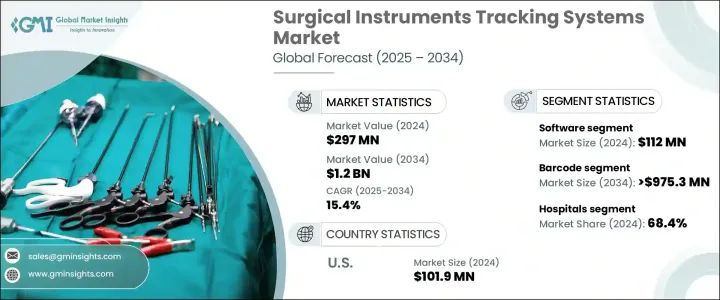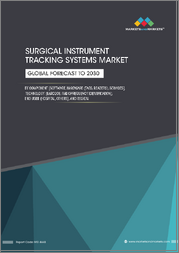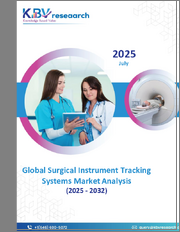
|
시장보고서
상품코드
1716653
수술 기구 추적 시스템 시장 기회, 성장 촉진요인, 산업 동향 분석 및 예측(2025-2034년)Surgical Instruments Tracking Systems Market Opportunity, Growth Drivers, Industry Trend Analysis, and Forecast 2025 - 2034 |
||||||
세계의 수술 기구 추적 시스템 시장은 2024년에 2억 9,700만 달러로 평가되었고, 2025년부터 2034년까지 연평균 복합 성장률(CAGR) 15.4%를 나타낼 것으로 예측됩니다.
이 시장은 세계의 건강 관리 시설이 환자의 안전, 규제 준수, 업무 효율을 우선하고 있기 때문에 강력한 성장을 이루고 있습니다. 엄청난 압박감에 노출되어 있으며 추적 시스템은 현대 의료 현장에서 필수적입니다.

헬스케어 인프라가 특히 신흥국을 중심으로 진화를 계속하고 있는 가운데, 워크플로우를 합리화하고, 비용을 절감하고, 전체적인 수술 결과를 개선할 수 있는 첨단 추적 기술에 대한 수요가 급증할 것으로 예측됩니다. 제조업체 및 서비스 제공업체에 큰 성장 기회를 제공하고 있으며, IoT 및 AI 기반 솔루션을 포함한 스마트 기술과 수술 기구 추적 시스템과의 통합은 의료 시설이 수술 자산을 관리하고 직원의 생산성을 향상시키고 세계 의료 표준에 대한 규정 준수를 확보할 수 있는 능력을 더욱 강화하고 있습니다.
| 시장 범위 | |
|---|---|
| 시작 연도 | 2024년 |
| 예측 연도 | 2025-2034년 |
| 시작 금액 | 2억 9,700만 달러 |
| 예측 금액 | 12억 달러 |
| CAGR | 15.4% |
수술 기구 추적 시스템 시장은 소프트웨어, 하드웨어, 서비스 등의 구성요소로 구분됩니다. 환자의 안전과 수술 기준에 대한 의무화가 진행되고 있는 가운데, 병원이나 진료소에서는 워크플로우를 자동화해, 수술 기구를 효율적으로 관리하기 위해서, 이러한 소프트웨어 플랫폼의 채용이 증가하고 있습니다.
기술 측면에서 시장은 바코드 시스템과 RFID 시스템으로 분류됩니다. 바코드 부문은 CAGR 15.1%을 나타내며 2034년에는 9억 7,530만 달러에 이를 것으로 예측됩니다. 병원, 특히 예산이 제한된 소규모 시설에서는 유연한 라벨링, 기존 관리 시스템과의 간편한 통합, 엄청난 투자 없이 수술 기구를 정확하게 추적할 수 있으므로 바코드 기반 추적이 선호됩니다.
미국의 수술 기구 추적 시스템 시장은 2024년에 1억 190만 달러를 창출했고 2034년까지 연평균 복합 성장률(CAGR) 14.3%를 나타낼 것으로 예상되고 있습니다. 미국 시장의 성장은 위생·안전 기준을 충족하기 위해 수술 기구의 추적을 의무화하는 엄격한 연방 규제에 의한 점이 큽니다. 추적 솔루션에 대한 수요가 더욱 높아지고 있으며, 표준화된 프로세스와 보다 나은 재고 관리의 필요성을 뒷받침하는 바코드 및 RFID 기술의 광범위한 채택이 이 나라 시장 성장에 크게 기여하고 있습니다.
목차
제1장 조사 방법과 조사 범위
제2장 주요 요약
제3장 업계 인사이트
- 생태계 분석
- 업계에 미치는 영향요인
- 성장 촉진요인
- 수술 건수 증가
- 수술 기구 추적 시스템의 기술적 진보
- 더 나은 재고 및 자산 관리의 필요성
- 고유 기구 식별에 관한 FDA 가이드라인의 의무화
- 업계의 잠재적 위험 및 과제
- 숙련된 전문가의 부족
- 수술 기구 추적 시스템의 높은 도입 비용
- 성장 촉진요인
- 성장 가능성 분석
- 규제 상황
- 기술 상황
- 정책 이니셔티브
- 갭 분석
- Porter's Five Forces 분석
- PESTEL 분석
- 밸류체인 분석
제4장 경쟁 구도
- 서론
- 기업 매트릭스 분석
- 기업 점유율 분석
- 주요 시장 기업의 경쟁 분석
- 경쟁 포지셔닝 매트릭스
- 전략 대시보드
제5장 시장 추계·예측 : 구성 요소별(2021-2034년)
- 주요 동향
- 소프트웨어
- 리더
- 태그
- 기타 하드웨어 부품
- 하드웨어
- 서비스
제6장 시장 추계·예측 : 기술별(2021-2034년)
- 주요 동향
- 바코드
- RFID
제7장 시장 추계·예측 : 최종 용도별(2021-2034년)
- 주요 동향
- 병원
- 외래수술센터(ASC)
- 기타 최종 용도
제8장 시장 추계·예측 : 지역별(2021-2034년)
- 주요 동향
- 북미
- 미국
- 캐나다
- 유럽
- 독일
- 영국
- 프랑스
- 스페인
- 이탈리아
- 네덜란드
- 아시아태평양
- 중국
- 일본
- 인도
- 호주
- 한국
- 라틴아메리카
- 브라질
- 멕시코
- 아르헨티나
- 중동 및 아프리카
- 남아프리카
- 사우디아라비아
- 아랍에미리트(UAE)
제9장 기업 프로파일
- B. Braun
- Becton, Dickinson and Company
- Case Medical
- FORTIVE
- GETINGE
- Haldor
- HID
- Integra
- KEIR SURGICAL
- SCANLAN
- spatrack
- STERIS
- SYRMA SGS
- Xerafy
The Global Surgical Instruments Tracking Systems Market was valued at USD 297 million in 2024 and is projected to grow at a CAGR of 15.4% between 2025 and 2034. The market is witnessing robust growth as healthcare facilities worldwide prioritize patient safety, regulatory compliance, and operational efficiency. With the increasing volume of surgical procedures and the growing complexity of surgical instruments, the need for advanced tracking systems has become more critical than ever. Hospitals and surgical centers are under immense pressure to maintain high sterilization standards and minimize surgical errors, making tracking systems essential in modern healthcare settings. The market is also benefiting from stringent regulations and guidelines that require healthcare providers to maintain accurate records of surgical tools, ensuring patient safety and reducing the risks associated with retained surgical instruments.

As healthcare infrastructure continues to evolve, particularly in emerging economies, the demand for sophisticated tracking technologies that can streamline workflows, reduce costs, and improve overall surgical outcomes is expected to surge. Moreover, growing concerns over hospital-acquired infections (HAIs) and the rising focus on optimizing instrument inventory and usage are creating significant growth opportunities for manufacturers and service providers in this space. The integration of smart technologies, including IoT and AI-based solutions, with surgical instrument tracking systems is further enhancing the ability of healthcare facilities to maintain control over surgical assets, improve staff productivity, and ensure compliance with global health standards.
| Market Scope | |
|---|---|
| Start Year | 2024 |
| Forecast Year | 2025-2034 |
| Start Value | $297 Million |
| Forecast Value | $1.2 Billion |
| CAGR | 15.4% |
The surgical instruments tracking systems market is segmented by components, including software, hardware, and services. Among these, the software segment accounted for USD 122 million in 2024, primarily due to its role in enhancing operational efficiency within healthcare environments. Software solutions are vital for inventory management, real-time tracking of sterilization processes, and ensuring seamless regulatory compliance. With growing mandates around patient safety and surgical standards, hospitals and clinics are increasingly adopting these software platforms to automate workflows and manage surgical tools effectively. The ability of software solutions to integrate with hospital databases and offer real-time insights makes them indispensable in reducing operational costs and improving the quality of care.
In terms of technology, the market is classified into barcode and RFID systems. The barcode segment is anticipated to grow at a CAGR of 15.1%, reaching USD 975.3 million by 2034. Barcode systems remain the most widely adopted technology, owing to their cost-effectiveness, ease of implementation, and high reliability. Hospitals, especially smaller facilities with limited budgets, prefer barcode-based tracking as it allows flexible labeling, easy integration with existing management systems, and accurate tracking of surgical instruments without significant investment.
The U.S. surgical instruments tracking systems market generated USD 101.9 million in 2024 and is expected to expand at a CAGR of 14.3% through 2034. Growth in the U.S. market is largely driven by strict federal regulations mandating the tracking of surgical tools to meet hygiene and safety standards. The rising number of surgical centers and outpatient clinics further escalates the demand for efficient tracking solutions. Additionally, the widespread adoption of barcode and RFID technologies, propelled by the need for standardized processes and better inventory control, is significantly contributing to the market's growth in the country.
Table of Contents
Chapter 1 Methodology and Scope
- 1.1 Market scope and definitions
- 1.2 Research design
- 1.2.1 Research approach
- 1.2.2 Data collection methods
- 1.3 Base estimates and calculations
- 1.3.1 Base year calculation
- 1.3.2 Key trends for market estimation
- 1.4 Forecast model
- 1.5 Primary research and validation
- 1.5.1 Primary sources
- 1.5.2 Data mining sources
Chapter 2 Executive Summary
- 2.1 Industry 3600 synopsis
Chapter 3 Industry Insights
- 3.1 Industry ecosystem analysis
- 3.2 Industry impact forces
- 3.2.1 Growth drivers
- 3.2.1.1 Increasing number of surgeries
- 3.2.1.2 Technological advancements in surgical instrument tracking systems
- 3.2.1.3 Need for better inventory and asset management
- 3.2.1.4 Mandatory FDA guidelines for unique device identification
- 3.2.2 Industry pitfalls and challenges
- 3.2.2.1 Lack of skilled professionals
- 3.2.2.2 High implementation costs of surgical instrument tracking systems
- 3.2.1 Growth drivers
- 3.3 Growth potential analysis
- 3.4 Regulatory landscape
- 3.5 Technology landscape
- 3.6 Policy initiatives
- 3.7 Gap analysis
- 3.8 Porter's analysis
- 3.9 PESTEL analysis
- 3.10 Value chain analysis
Chapter 4 Competitive Landscape, 2024
- 4.1 Introduction
- 4.2 Company matrix analysis
- 4.3 Company market share analysis
- 4.4 Competitive analysis of major market players
- 4.5 Competitive positioning matrix
- 4.6 Strategy dashboard
Chapter 5 Market Estimates and Forecast, By Component, 2021 - 2034 ($ Mn)
- 5.1 Key trends
- 5.2 Software
- 5.2.1 Readers
- 5.2.2 Tags
- 5.2.3 Other hardware parts
- 5.3 Hardware
- 5.4 Services
Chapter 6 Market Estimates and Forecast, By Technology, 2021 - 2034 ($ Mn)
- 6.1 Key trends
- 6.2 Barcode
- 6.3 RFID
Chapter 7 Market Estimates and Forecast, By End Use, 2021 - 2034 ($ Mn)
- 7.1 Key trends
- 7.2 Hospitals
- 7.3 Ambulatory surgical centers
- 7.4 Other End Use
Chapter 8 Market Estimates and Forecast, By Region, 2021 - 2034 ($ Mn)
- 8.1 Key trends
- 8.2 North America
- 8.2.1 U.S.
- 8.2.2 Canada
- 8.3 Europe
- 8.3.1 Germany
- 8.3.2 UK
- 8.3.3 France
- 8.3.4 Spain
- 8.3.5 Italy
- 8.3.6 Netherlands
- 8.4 Asia Pacific
- 8.4.1 China
- 8.4.2 Japan
- 8.4.3 India
- 8.4.4 Australia
- 8.4.5 South Korea
- 8.5 Latin America
- 8.5.1 Brazil
- 8.5.2 Mexico
- 8.5.3 Argentina
- 8.6 Middle East and Africa
- 8.6.1 South Africa
- 8.6.2 Saudi Arabia
- 8.6.3 UAE
Chapter 9 Company Profiles
- 9.1 B. Braun
- 9.2 Becton, Dickinson and Company
- 9.3 Case Medical
- 9.4 FORTIVE
- 9.5 GETINGE
- 9.6 Haldor
- 9.7 HID
- 9.8 Integra
- 9.9 KEIR SURGICAL
- 9.10 SCANLAN
- 9.11 spatrack
- 9.12 STERIS
- 9.13 SYRMA SGS
- 9.14 Xerafy



















